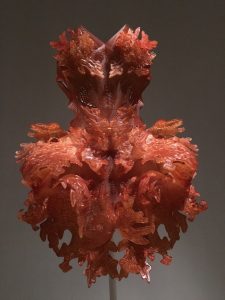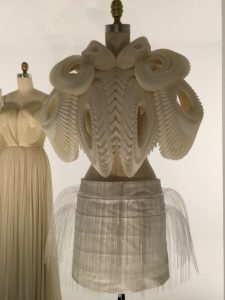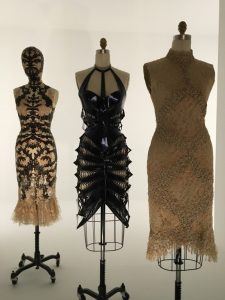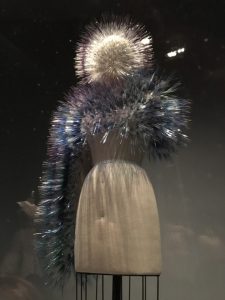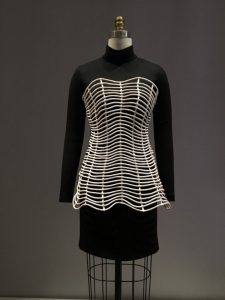Craft enters the realm of art when it moves our emotions, and art enriches our lives as it bookmarks our times. The Costume Institute’s spring 2016 exhibition, “Manus x Machina: Fashion in an Age of Technology” at New York’s Metropolitan Museum of Art, once again demonstrates that fashion stirs our passion and reflects our culture. If one were to hold a mirror to the face of fashion, the reflected image would be us.
The exhibition at the Met was the brainchild of Andrew Bolton, curator in charge of the Costume Institute. This fashion extravaganza clearly spotlights the confluence of the hand (manus) and the machine (machina). With the founding of haute couture in the 19th Century and the advent of the sewing machine, there has been a chasm between the virtues of the hand and the powers of the machine in the creative process. The exhibition, sponsored by Apple (the producers of a machine), and designed by the New York location of Rem Koolhaas’ Office for Metropolitan Architecture, denotes the evolution of our culture and the synergy between hand and machine.
Today, our lives are changing faster than ever before; the rate of change is exponential. As we adapt to the inevitabilities of evolution, the relentless march of technology has fostered doubt and concern over the future of the physical retail store. And while the retail industry has historically been quick to embrace change and various innovations of the day, care must be given to avoid the trap of technology.
While technology will clearly define and drive the future, it must be noted that human nature tends to push in one direction or the other. It must be remembered, however, that balance will define the vortex of success – the hand and the machine must work together.
As we move forward through time and technology, it’s important to recognize that effective design is timeless, universal and contemporary. As such, it must embrace both the hand and the machine. In speaking of the Manus x Machina exhibition, luxury fashion designer Karl Lagerfeld said, “Perhaps it used to matter if a dress was handmade or machine-made, at least in the haute couture, but now things are completely different …The digital revolution has changed the world.”
As retailers scramble to board the speeding technology train, they will do well to understand that technology must be seamlessly integrated into their culture and into their environments. Much like an art exhibition – or a fashion show, for that matter – it must be curated and strategically positioned. It must work hand in hand, no pun intended, with the physical consumer and brand touchpoints.
Advertisement
The description of a Prada dress at the Manus x Machina exhibition read: “Machine-sewn green silk organza, machine-embroidered with white cotton floral motifs superimposed with hand-embroidered white plastic sequins, rhinestones and beads.” Similarly, a wedding ensemble by Yves Saint Laurent was described in the following manner: “Bridal wreath, bracelet and anklet; handmade pink and gold silk flowers and leaves by Lemarie; train: machine-sewn pink silk gazar.”
These descriptions illustrate that the hand and the machine can work together. The direction of the retail industry illustrates that brick-and-mortar and digital can and must work together as technology evolves.
Eric Feigenbaum is a recognized leader in the visual merchandising and store design industries with both domestic and international design experience. He served as corporate director of visual merchandising for Stern’s Department Store, a division of Federated Department Stores, from 1986 to 1995. After Stern’s, he assumed the position of director of visual merchandising for WalkerGroup/CNI, an architectural design firm in New York City. Feigenbaum was also an adjunct professor of Store Design at the Fashion Institute of Technology and formerly served as the chair of the Visual Merchandising Department at LIM College (New York) from 2000 to 2015. In addition to being the Editorial Advisor/New York Editor of VMSD magazine, Eric is also a founding member of PAVE (A Partnership for Planning and Visual Education). Currently, he is also president and director of creative services for his own retail design company, Embrace Design.


 Photo Gallery2 days ago
Photo Gallery2 days ago
 Headlines1 week ago
Headlines1 week ago
 Headlines2 weeks ago
Headlines2 weeks ago
 Sector Spotlight2 weeks ago
Sector Spotlight2 weeks ago
 Headlines1 week ago
Headlines1 week ago
 Headlines4 days ago
Headlines4 days ago
 Headlines2 weeks ago
Headlines2 weeks ago
 Designer Dozen1 week ago
Designer Dozen1 week ago





